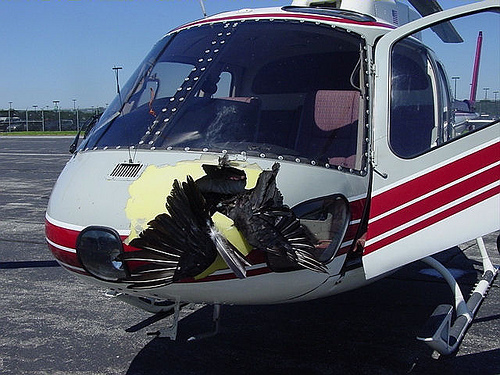Drones + Helicopters = Damage

At a recent professional meeting, a colleague related to me a chilling tale told at last month’s Helicopter Association International (HAI) Heli-Expo meeting in Orlando:
A helicopter cinematography crew was nearly struck by a multi-rotor drone while they were surveying an area for a movie shoot. The understandably rattled pilot decided to follow the drone back to its ‘home’ and reported the operator to the FAA (it is important to note that there was a considerable distance between the movie shoot location and the drone’s ‘home’). The operator was apparently well versed in the regulations and told the FAA that he was operating the drone for recreational purposes within visual line-of-sight and that he landed the drone immediately upon seeing the helicopter. The FAA apparently ‘bought’ the operator’s story. But, to make matters far, far worse, the helicopter pilot subsequently received notice of an FAA enforcement action against him that, if unsuccessfully fought, might result in the pilot losing his license. Apparently the drone operator did not like the fact that the helicopter pilot took a picture of his home (and, more importantly, his address) and reported to the FAA that the pilot was flying at very low altitude over a populated area. The bottom line is that the helicopter pilot is now paying legal bills to fight an enforcement action when he ought to have been rewarded for tracking down someone who should have been charged with reckless endangerment.
Two drone hobbyists in New York last year were not so lucky. As reported by CBS on their website, two drones operated by the hobbyists almost hit an NYPD helicopter. After following the drones back to their operators, the police helicopter crew informed street patrol officers on the ground who arrested the two and did indeed charge them with reckless endangerment.
An analysis performed last year by Exponent Failure Analysis Associates (Exponent) on behalf of the UAS America Fund LLC and the law firm Kramer Levin Naftalis & Frankel LLP used historical aircraft bird strike data as an analog for determining the risk to manned aircraft posed by micro UAVs (i.e., drones weighing less than 3 pounds). In the Exponent report, it was noted that there were very few strikes from small and medium sized birds at altitudes below 400 feet at distances of more than 5 miles from airports. Specifically, in the 24.5 year period from 1990 through mid-2014, there were only 34 cases of damage to aircraft, only 6 collisions resulting in injuries and none resulting in fatalities (under the aforementioned conditions). The report concludes that, based on the bird strike analysis, micro UAVs operating under the same conditions will not pose an increased risk to manned aircraft.
However, the report also notes the analysis assumes that drones and birds will operate in the same way. However, until drones have at least the same ‘see-and-avoid’ capability as birds, the assumption is significantly flawed if non-line-of-sight operations are permitted. No bird will intentionally fly straight into an aircraft. A drone operating beyond line-of-sight to its operator, however, certainly could do so under the right circumstances. Furthermore, since the Exponent report was focused on small and medium sized birds (in support of the micro UAS petition for rulemaking), it did not discuss the fact that, even with their natural see-and-avoid capabilities, bird strikes with ‘large’ birds are both frequent and a handful are very damaging.
During 2013 alone, 265 wildlife strikes were reported that involved helicopters (as reported in the November 2014 newsletter Bird Strike Buzz). Of these, 18 caused significant damage. One strike with a black vulture (25 inches long and approximately 2 kg) caused well over $100,000 damage and resulted in the aircraft being out of service for 139 days. (For additional analysis, see a USDA blog post here) The FAA’s small UAS proposed rule governs drones weighing less than 55 pounds. The bird strike data from ‘large’ birds is just one reason why the proposed rule has a line-of-sight restriction. However, until severe penalties for reckless operation are on the books and widely known, careless operators will continue to let their toys run free, beyond line-of-sight, with the comfort that the built-in fly-back-home feature will return their $500 investment.
When will hobby drones be shipped with a huge warning sticker on the front of the box? Something to the effect of: “WARNING: Reckless operation of this unit (e.g., at altitudes above 400 feet and/or beyond visual line-of-sight) may result in civil and criminal penalties ranging from a minimum fine of $25,000 to a maximum sentence of 5 years in prison, or both.”
Clearly not all helicopter pilots are police officers with colleagues on the ground to assist. Hobby drones pose a significant risk to helicopter operations if they are operated beyond visual line-of-sight. While state and local legislatures around the country focus attention on preventing UAS-based surveillance abuse by law enforcement (even though not a single incident of abuse has yet occurred …), perhaps they ought to send a message to reckless drone hobbyists. The FAA has a wildlife strike database. Will it need to start a drone strike database before lawmakers act?
